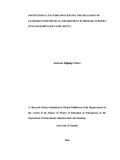| dc.description.abstract | Due to the influx of refugees into Daadab refugee camp, there are many learners with physical impairment in the camps learning in regular schools. The study sought to investigate institutional factors influencing the inclusion of the physically impaired refugees in primary schools in Daadab refugee camp, Kenya. The objectives of the study were on the influence of: UNHCR policies, learner –Friendly environment, Competencies of teachers and support staff and strategies to enhance inclusive education. The study targeted 19 primary schools in Daadab refugee camp. The researcher sampled 18 primary school head teachers, 80 teachers, 1 County Director of Education, and 98 children. The study used descriptive research design. Questionnaires, interview guides and Focus Group Discussion guide were used to collect data. Data collected were analyzed qualitatively and quantitatively, these included frequencies, tables, percentages and texts for clarity. The study established that the UNHCR policy on documentation such as birth certificate and proof of refugee status hindered many refugee children from attending regular schools. Moreover, it established that the learning situation in Daadab refugee camp was not learner friendly. There was a serious congestion of learners in classrooms. Facilities were in dilapidated condition and needed improvement. Learning materials were not enough and the learners with physical impairment could not get adequate space for movement. The schools also lacked assistive devices like ramps and crutches to facilitate physical mobility of the learners with physical impairment. It also revealed that teacher’ and support staff lacked the necessary skills to handle vulnerable learners such as refugees and more specifically those with physical impairment. It revealed useful suggestions on strategies that can strengthen Inclusive education in Daadab refugee camps. Among these were increased partnerships with development partners other than UNHCR. In a nutshell, the four factors under investigation namely: The influence of UNHR policies, the influence of learner friendly environment , the influence of competencies of teachers and support staff and suggested strategies all had influence on Inclusion of the targeted learners in Daadab refugee camp. The study recommended that the government should work in partnership with United Nations High Commission for Refugees (UNHCR) and the NGO’s operating in the area such as CARE and Handicap International to make the learning environment for the refugees learner friendly. Funding for schools which enrolled refugees with physical impairment should be increased to ensure that provision for them is adequate. Training of teachers in the area of inclusive education should be expeditiously done to equip them with prerequisite skills to handle learners with special needs. The teacher shortage should also be addressed by employing trained teachers to the schools. The study suggested future areas of study to find out the effectiveness of inclusive education for other categories of disability such as visual, hearing, and intellectual impairments. Further it suggested a study on the impact of education received in the refugee camps especially when repatriation becomes ideal. | en_US |

